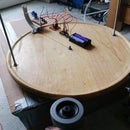Introduction: Magnetic Barkhausen Effect and Hysteresis Curve
Due to the angular momentum/spin of the electrons, the atoms have a microscopic magnetic moment. A more or less strong magnetization then appears macroscopically, depending on whether the atomic magnetic moments cancel each other out or not. The magnetic moments are arranged in so-called Weiss domains. Within such a domain, the magnetic moments have the same orientation. However, if the individual areas are compared with one another, there is total disorder without an external magnetic field. Only in an external magnetic field do the magnetic moments of the Weiß domains align themselves in parallel and thus strengthen the external magnetic field. This is typical for so-called ferromagnetic materials such as iron.
This amplification of the external magnetic field can be illustrated in the form of the so-called hysteresis curve. The external magnetic field (H-field) is plotted on the x-axis, i.e. the cause. The magnetic field (B field) amplified by the body is then plotted on the y-axis. First, with increasing H-field, the B-field also grows strongly, since more and more Weiss domains are aligned in parallel. However, if the H field continues to increase, gradually all the magnetic moments of Weiss' domains are already aligned and the amplification slowly decreases. This can be seen from the fact that the hysteresis curve slowly flattens out. If all Weiss domains are then oriented in parallel with a further increase in the H field, the material can no longer provide any additional amplification and the resulting B field only increases as a result of the sole increase in the H field. In this range, the hysteresis curve only has a very small slope.
If the external magnetic field (H-field) is reduced, the Weiss domains initially remain parallel for a relatively long time. Even with no external magnetic field (H = 0), a certain residual magnetization remains. This is called remanence. Only when you reverse the polarity of the external magnetic field and increase it in the opposite direction does the resulting B field decrease to 0. The opposing field required for this is called a coercive field. If the opposing field is enlarged even further, the resulting B field then grows again as before, but now in the opposite direction. In this way, the so-called hysteresis curve is obtained for a full revolution.
Supplies
To record the hysteresis curve, we need a coil, a soft iron core, a magnetic field sensor (Hall sensor), a shunt resistor (1 ohm) and an oscilloscope in x/y mode. My coil was wound with a 0.3mm enameled copper wire and has an ohmic resistance of around 83 ohms and an inductance of 427 mH. This means that it can be operated on the 230V AC mains, at least for a short time. The H field is proportional to the current I flowing through the coil. This current I generates a voltage drop U at the shunt resistor according to Ohm's law U = R*I. This voltage is placed on the x-axis of the oscilloscope.
The effect of the magnetization, the B field, is on the y-axis. This can be measured with a so-called Hall sensor. I am using the CYSJ362A sensor. This can measure flux densities up to 3T. The Hall sensor provides an output voltage that is proportional to the B field (1.5 V/T with a 5V supply voltage). The sensor is positioned at the end of the soft iron rod, which is in the coil. The output voltage is then placed on the y-axis of the oscilloscope. If you now connect the coil to the mains (230V AC), you get a nice hysteresis curve. But ATTENTION: The negative pole of the oscilloscope inputs is grounded. Therefore the shunt resistor must be connected to the neutral line and not to the phase! This guarantees that the grounded input of the oscilloscope is also connected to the mains ground and not to the phase. Because this would result in a fatal short circuit and will almost certainly destroy the oscilloscope!
Step 1: The Magnetic Barkhausen Effect
In the introduction I talked about the hysteresis curve and its cause. As the external H field increases, the magnetic field (B field) intensifies due to the flipping of Weiß's domains. This flipping of the atomic magnetic moments can even be made audible. For this you need the soft iron rod, the coil, a strong permanent magnet and a small audio amplifier with loudspeaker.
The hysteresis curve has very small jumps as a result of this flipping of the Weiss domains. The B-field changes in leaps and bounds. If the soft iron rod is now in the coil and the B field changes, the magnetic flux through the coil also changes and an electrical voltage is induced according to Faraday's law of induction. If you connect the coil to the small audio amplifier including loudspeaker, you can hear these jumps in the form of crackling or noise when you stroke the outside of the coil with the permanent magnet.
To check whether the magnet itself is producing the noise, you can remove the soft iron rod from the coil and then move the magnet on the outside of the coil as well. This time you won't hear any noise. Only with a soft iron rod inside the coil can you hear the Barkhausen jumps again, i.e. the flipping of the atomic magnetic moments in an external magnetic field.
Step 2: Video and Further Physics Projects
So even tiny atomic changes can be perceived with our senses. The Barkhausen effect was named after its discoverer, Heinrich Barkhausen, who first observed this noise in 1917.
If you are interested in other exciting physics projects, then visit my homepage or my YouTube channel.
On that note, stay curious and Eureka!




